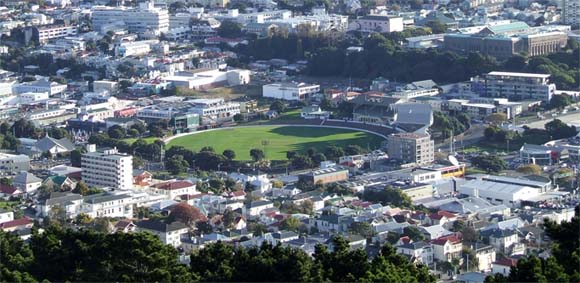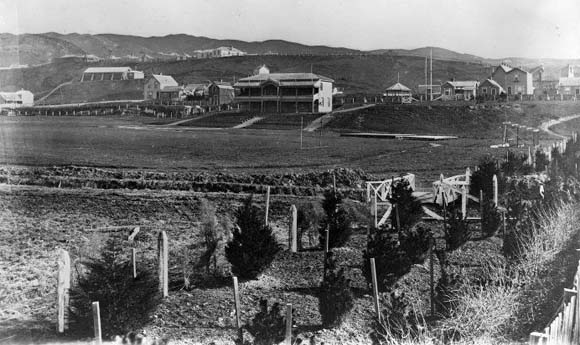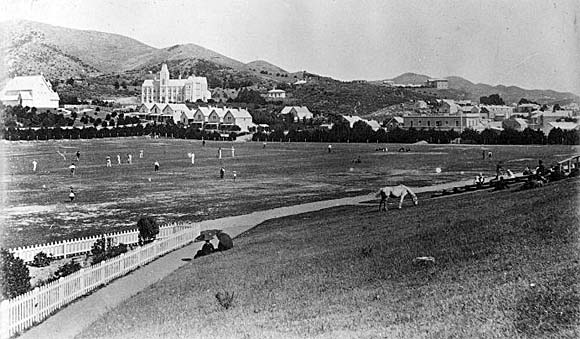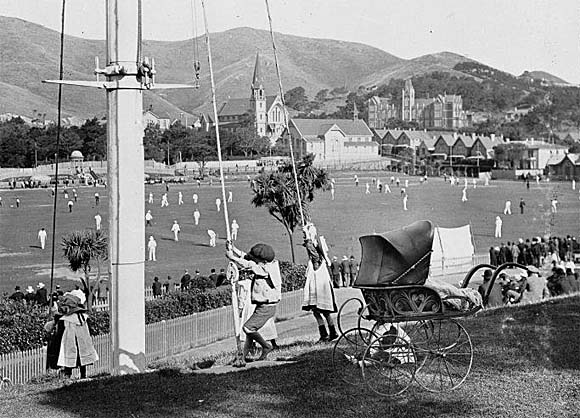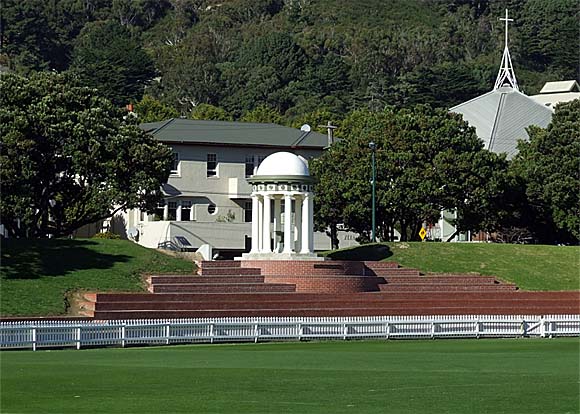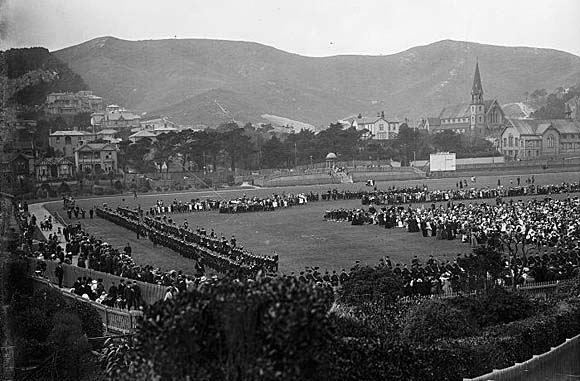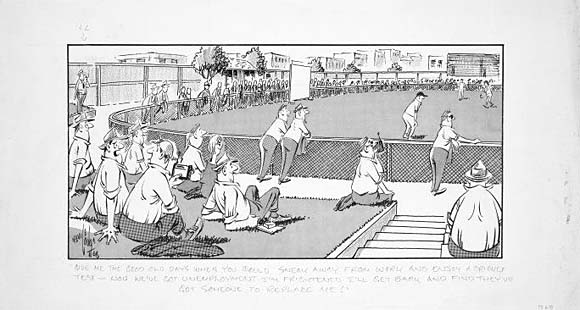|
Zeitblick
/ Das Online-Magazin der HillAc -
21. Juni 2009 - Nr. 34
|
|
City, My City |
|
|
Series 4, Part 5 The Biggest Roundabout in the Southern Hemisphere Like a large island in the middle of a swift moving torrent the Basin Reserve divides east-west and north-south traffic flowing into and out of Wellington city, a divide which forms what is known as the biggest roundabout in the Southern Hemisphere. This story of the Basin Reserve, Wellington's historic cricket ground, is dedicated to friends, Fred and Diana Goodall. Before his retirement Fred was one of New Zealand's foremost cricket umpires and Diana a staunch supporter of both local and national cricket and an accomplished umpire in her own right. Both remain stalwart friends of "The Basin" acknowledging its place in regional and national cricket, its distinguished history and the importance of its enduring part in the future of Wellington. In fact "The Basin" is so important to Fred and Diana that, on June 1st 1991, they were married in the centre of its hallowed ground. "...and umpire Fred Goodall raised his finger to send Border packing - and
Although potential Russian and Japanese invasions have caused unease at different times in our history, the city of Wellington has never come under threat from the armies of man - and long may this continue. The forces of nature, however, are an entirely different concern. In the months leading up to January 1855, deep beneath New Zealand, the movement of opposing tectonic plates - Australian to the west and Pacific to the east - was building up an enormous amount of kinetic energy. The latent energy in a magnitude 5 earthquake, 30 times that of a magnitude 4 quake, is equal to the energy in one Hiroshima-size atomic bomb. Anything larger increases this amount of energy exponentially rather than by degrees so imagine, then, the force contained within a magnitude 8.2 earthquake centred a scant 25 kilometres below the surface of the earth. Strong winds and heavy rain prevailed during the day of January 23rd whilst that evening the conditions became eerily quiet and calm, customarily known in New Zealand as "earthquake weather". Not long after 9:00pm on that evening the Wairarapa fault line to the east of Wellington gave way under the strain of this enormous pressure and ruptured along 140 kilometres of its length. Buildings and people were understandably greatly affected by the quake but the most dramatic impact was to be a significant uplift of land within Wellington and the Wairarapa, by upwards of 2.7 meters. Low-lying areas in Te Aro, Miramar and along the southern and western coasts of Wellington Harbour were raised by 2 meters and the "The Basin" was raised by at least 1.8 meters. On the arrival of the first immigrant ships in 1840 the area today known as The Basin Reserve was a lake formed by the confluence of runoff from Mount Victoria, Mount Albert and Mount Cook. The plans drawn up by the founding fathers identified this area as a potential inland harbour surrounded by warehouses and factories and providing sheltered anchorage adjoining Wellington Harbour. Access to this inner harbour was to be by way of a broad canal formed by the enlargement of an existing stream which provided run-off from the lake to the harbour. This access followed the route now taken by Kent and Cambridge Terraces and is the reason these streets and their median are so broad. The earthquake of 1855 made these plans no longer possible and "The Basin" became, instead, a muddy swamp.
Despite continued rumbles and shakes beneath the earth, the young city grew by leaps and bounds and had, by the end of 1855, topped 6,000 residents. While these citizens needed somewhere to live and somewhere to earn a living they also needed somewhere to play and Wellington was noticeably short of recreational reserves. This was believed to have been due to negligence on behalf of the founding fathers and the city planners but there is another likely explanation. The plans drawn up in England for the city were designed for a large flat area on the northern side of the harbour at Petone. When it became obvious, however, that this location was unsuitable, these same plans were then overlaid on Thorndon on the harbours southern coast, an altogether smaller and irregular region. In order to make the town fit this area something had to be discarded which would, more than likely, have been those areas set aside for recreation. Apart from some flat but rather irregular regions at Te Aro, Wellington residents enjoyed nothing in the way of open, level expanses until the solution, quite literally, arose in front of them with the 1855 earthquake. Nothing much was done for two years following the earthquake but in 1857 a group of influential Wellington citizens appealed to the Provincial Council to set aside the site of the Basin and its Canal to be used as "...a public park and cricket ground...". The appeal stated that "... as the ground is perfectly level and of about 8 acres it is.....well adapted for the above purposes as a place of recreation." Their appeal was accepted and, on February 3rd, 1863, using convict labour from nearby Mount Cook Gaol, the immense and costly task of draining The Basin began. The Wellington Independent newspaper of February 5th, 1863, approved of the action, speaking in eloquent terms of the benefit of outdoor exercise: "We are glad to observe that the gang of prisoners are now employed in the preliminary operations necessary for the draining of the swamp at Te Aro Flat to form it into a Park and Cricket Ground for the recreation of the citizens." And again: "The rising generation are saved from the temptations of the tap room, and debilitating in door dissipation is exchanged for the healthy exhilaration of open air exercise." Hmmmm! Now where have I heard that before?
The prisoners dug a broad, deep channel running north by south across the Basin, which discharged into a large drain dug from there to the sea on the coast at Te Aro. This drain, following the path of the original stream from the lake, had been enlarged and ran along the route followed by present day Kent and Cambridge Terraces. The work proceeded quickly and by September 1863, a mere 9 months since the prison gangs began, the Basin had been "...reclaimed from a state of impossible swamp to available and almost dry land." It had been previously reported that it was the intention of the City Reserves Commissioners to fence the entire area but there were "no funds in hand to carry out their plans" and this part of the vision was put on hold. It was hoped that a public collection would bridge this gap and "several gentlemen" had already volunteered to assume the responsibility of collecting subscriptions from citizens of interest and of means. The Provincial Government of the day agreed to supplement whatever sum was gathered and soon, with sufficient funds now available, the entire area of the new Basin Reserve was surrounded by a railed fence, backed by a thorn hedge. The movement of the seat of government from Auckland to Wellington in October 1864 brought with it a significant increase in Wellington's population and this newly available recreation land would no doubt soon be fully utilised. However interest in the further development of the Basin abated for a few years and it was not until December 11th 1866 that the location was officially recognised as the city's home of cricket. On this date an agreement was signed between the Board of Works and a committee of enthusiastic citizens to whom the Basin was to be leased for 3 years at an annual rental of £25, fences would be maintained and horses and cattle would be excluded from grazing on the ground. This became, perhaps, New Zealand's first "Public/Private Partnership" and the township was well on its way to becoming a city of sport, of culture ........... and of public servants.
It wasn't until early January 1868, almost exactly 13 years since the earthquake had raised the lake bed, that the earliest games of cricket began to be played on the Basin. In the first game, a team called the "Falcons", made up of crew members from the British warship, HMSS Falcon, which had arrived in Wellington on the evening of January 6th 1868, challenged a "Volunteer" team from Wellington. The match took place at the Basin on January 11th and was won by the "Falcons" while a return match played on the following Saturday was also, as the Wellington Independent newspaper put it "...won by the tars." A few days later a cricket club from Rangitikei north of Wellington challenged the Wellington team to a game played, as mentioned in the Evening Post of February 18th, 1868 "...on the new ground." In this article the publishers of the Evening Post announced that "We congratulate the cricketers of Wellington on the opening of their Cricket Reserve for play. It is now some 6 years [exaggeration?] since drains were cut in it and fences erected round it, and it has been an arduous task to bring the former swamp into a condition fit for cricket". They also pointed out that "The grass is rather bare in places, but we have often witnessed good matches played on worse ground". It is interesting, though, that the umpire at that time, Bruce Wallis, apologised to the players for the state of the ground which caused injuries to players hands and fingers. However, such was the goodwill surrounding this event that the Evening Post suggested a movement be made "...to get up a holiday for the occasion". There is no evidence that "...a general half-holiday" occurred but there were certainly celebrations surrounding the event such that the merchants of the city were entertained on board the HMSS Falcon and the members of the Rangitikei cricket team were wined and dined at Osgood's famed Wellington hotel. The game, popular but with little support and certainly with nowhere previously to be played, was now catching on. The visiting team from Rangitikei, perhaps flushed with enthusiasm, challenged the "Falcons" to a match on Friday 21st, which the "Falcons" won, and a return match was agreed to be played on Sunday February 30th. These sailors from the Falcon certainly seemed to be ardent sportsmen as they later challenged a Wellington shooting team to a match. This same article from the Wellington Independent concluded "What is true in England is equally true in the colonies, more especially in New Zealand, and we therefore sincerely hope that the present movement will not only be successful, but may also be the beginning of a new era, in the gradual but universal recognition of out-door sports, as an institution in Wellington."
The success of these initial matches drew interest from other sporting groups within Wellington now provided with a suitable ground for their out-door pursuits. The first of these groups to show interest was the Wellington Caledonian Society which organised Highland Games to be held on January 1st 1869 to coincide with New Years Day and the visit to Wellington of the New Zealand Governor, Lord Bowen and his wife. Like Caledonian Games held in many other towns and locations in New Zealand the Wellington games included such events as the "Foot Race, 200 yards"; "Throwing the heavy stone"; "Vaulting with the pole"; "Throwing the hammer" and that most Scottish of events "Tossing the caber". Prize money was offered which attracted competitors from many other parts of the Province and the ideal site to hold these games, in fact the only site at that time, was the Basin Reserve. Their success was reflected upon in the Evening Post of January 2nd 1869 when it was reported that; "The whole of the affair passed off quietly and satisfactorily; and the manner in which the arrangements were made and carried out reflects the highest credit on the committee..." In the following year, 1870, our committee of enthusiastic cricketers applied to have their lease on the playing field extended, an application which was turned down. They were instead offered an alternative lease through a group of three trustees: Mr Cutts, representing the citizens of Wellington; Mr Crawford, representing the Caledonian Games Committee; and Mr Buchanan, representing the cricket players. This lease was for a term of 3 years at an annual rate of £20 and, as with the previous agreement, the maintenance of the ground remained the responsibility of the lessees. At the conclusion of the lease period, on March 20th 1873, the Basin was formally deeded to the people of Wellington as a public utility through the Wellington City Council by order of the Wellington Provincial Superintendent, William Fitzherbert. This deed provided that the Basin and its associated Canal Reserve be "...for ever hereafter used and appropriated as a public Recreation ground for the inhabitants of the City of Wellington..." and stipulated that "...no thoroughfare shall at any time be created across the said lands or any part thereof...". Although this charter is now 136 years old, its stipulations must be considered now no less binding than when the ink was wet on the page. It is the spirit in which this deed was granted that the Wellington City Council - the original and appointed guardians of the Basin - are now in danger of violating with their proposal to build a motorway flyover across the southern end of the Basin Reserve. For the sake of those who hold the Basin dear, may they seriously reconsider their plans.
Over the balance of the 19th Century the development and refinement of the Basin continued. The surface of the ground was transformed from a rocky, swampy field - a one time lake-bed in all respects - to a complete sports ground of international standing. The Eastern Bank, today a favoured place to sit in the sun and view the spectacle of a fine game of cricket, was built up whilst a secure outer fence now encircled the whole ground. As a facility the Basin became the gathering place, the "Social Hub" as Neely puts it, of the city. Whilst cricket remained the only Summer attraction, other sports also occupied the ground including football, rugby league, Australian rules football, hockey, athletics and a whole range of outdoor pursuits. In 1881 the future of the ground came under threat when the Public Works Committee suggested that it become a pleasure park and garden and that cricket and football be restricted to Newtown Park. Thankfully this recommendation was not adopted and even one of the local newspapers came to the defence of the Basin, and of local cricketers, in its August 9th issue when it wrote "The funds expended by the cricketers year after year upon the reserve had to a large amount been wasted. The cricketers paid no less that £150 per year which footballers had destroyed during the season devoted to their favourite, but decidedly dangerous sport". The subsequent repairs to the ground resulting from this damage took over a year and on October 7th 1882, with much celebration, the ground reopened. This opening was accompanied by a significant resurgence of interest in cricket with clubs across the region recording more than 300 players on their books. Then again in 1897 a local councillor, W H Barber, suggested widening Cambridge and Kent Terraces and extending them through the Basin to meet Adelaide Road on the southern side. Once more in its history the future of the Basin had been a near run thing but again many, including John Plimmer the so called "Father of Wellington", had leapt to its defence. Surrounded but never overwhelmed by a rapidly expanding city, there is no doubt that over the years the Basin has been viewed as a very valuable piece of land. Many of us see this value in the existence of the Basin as a recreation ground in its own right whilst others look at it for its developmental value and little else. In 1904 an attempt was made to induce the council to seek parliamentary authority to run an electric tram though the Basin, a scheme which, had it succeeded, would have destroyed the integrity and worth of the Basin as a playing field. Whilst the matter did go to Parliament several years later in 1915 - perhaps with the thought that the distraction of the war would have allowed the bill to slip through un-noticed - the proposal was thrown out.
Over the life of New Zealand and the city of Wellington - minus 15 years - the Basin has endured. Many attempts have been made to capitalise on this priceless piece of real estate but all, to date, have thankfully failed. Over the 20th and 21st centuries the Basin continues to be a sports ground, a gathering place, a place of mass communion, a place of celebration, a place of spectacle and, for many of us, a place of peace. The Basin hosted the first remembrance of New Zealand's appointment to the status of Dominion within the British Commonwealth (September 26th 1907), numerous ANZAC Day celebrations which continue to strengthen our unique New Zealand identity, concerts and band performances, military displays, Maori cultural exhibitions, marching displays, hot air balloon displays and the occasional wedding. Then as now the Basin proved suitable for providing, with occasional support from other local grounds, the recreational and assembly requirements of the city. "The Basin", for this is what it is known as by all of Wellingtons residents, is a sports ground, a focal point, a bus stop, a location and a roundabout but I must admit that unless you know what is inside that fence as you drive around it, the location just seems to be a big circular road. The opening of the Wellingtons excellent Westpac Stadium on January 8th, 2000 has relieved much of the pressure on the Basin by providing an optional venue of significant size within the region. The ground, however, is not a favoured location for cricket within Wellington and, as much as possible, this sport will continue to be played on the Basin Reserve.
To many of us the Basin Reserve is holy ground, the sanctuary of Wellington cricket whose past and present are enshrined within the soul of this city. Let us hope that this also applies to its future. Indeed the Basin is the only sports ground in the country which holds, under the Historic Places Trust, an Historic Area registration. On occasion one of the places I have enjoyed has been the raised Eastern Bank in front of which women in summer attire and businessmen in suits and ties, absconding from their offices for a few hours of enjoyment, run the gauntlet of the circular walkway enduring friendly taunts from the crowd about their style of dress and what should be done with it. The Basin is a picturesque cricket ground, its playing field is surrounded by a quaint white picket fence reminiscent of those English country cricket grounds back in the "Home Country" as it was once known. When one is inside the ground, enclosed by its tall fences, embankments and grandstands the perception of peace is complete. If you need somewhere to escape, to sit silently and to avoid the bustle of the day, try the Basin Reserve. Once there it is difficult to believe that one is in the centre of a busy metropolis.
© Peter Wells, Wellington, New Zealand |
